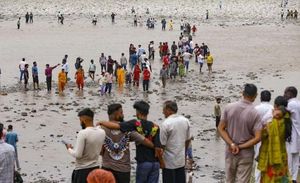Google is at the center of controversy following the issuance of false earthquake alerts to millions of Android users across Brazil, sparking panic and confusion. Early on February 14, around 2:20 AM, residents of São Paulo, Rio de Janeiro, and Minas Gerais received alerts indicating seismic activity near Ubatuba, São Paulo. The alerts, sent via the Google Alert System, claimed there was a possible earthquake 55 kilometers off the Brazilian coast, leading to widespread concern.
Emergency services and several official geophysical organizations quickly refuted the claims. The São Paulo Civil Defense, along with the Brazilian Seismographic Network, confirmed there were no significant seismic events occurring. This swift response highlighted the effectiveness of Brazil's existing earthquake monitoring systems and contradicted the alerts received on mobile devices, creating confusion among users.
Recognizing the situation's severity, the National Telecommunications Agency (Anatel) initiated an administrative investigation to determine how such false alerts could be generated and disseminated. Anatel aims to analyze the telecommunications systems involved and implement measures to prevent future incidents, ensuring public trust in emergency alert systems remains intact.
According to reports, Google confirmed the malfunction, providing insights on what led to the erroneous alarm. The tech giant explained their system detected abnormal signals from several nearby mobile devices, which led to the automatic push of the earthquake warning. Google clarified this system is not intended to replace official alerts but serves as a supplementary tool to help warn of potential seismic activities.
Despite millions being notified, no actual seismic activity was recorded, highlighting the risks inherent to relying on non-verified digital alert systems. Aderson Nascimento, vice president of the Brazilian Society of Geophysics, emphasized the need for transparency and accuracy from Google, stating, “Ninguém teve acesso a esses dados nem a esse algoritmo, então fica essa dúvida.” He noted how algorithms based on cell phone data analysis could lead to misinterpretation, particularly if many devices respond to inconsequential vibrations.
Nascimento explained the complexity of the processes involved: “O que acontece na maior parte desse sistema de alerta é que eles usam o sensor de movimento que nós temos no celular.” He underscored the necessity of human verification before alerts are dispatched, particularly as these digital alert systems gain prominence. “Os alertas desses tipos precisam ser revisados por um ser humano,” he asserted, stressing the importance of maintaining credibility without compromising safety.
Google has since reassured users, stating they are actively investigating the incident and have temporarily disabled the earthquake alert feature within Brazil until the problem is resolved. They issued an official statement citing their commitment to improving alert systems, saying, “Pedimos desculpas aos nossos usuários pelo inconveniente e seguimos comprometidos em aprimorar nossas ferramentas.”
The investigation will analyze the algorithms and data management processes, exploring whether this incident was simply coincidental—a convergence of normal device vibrations mistaken for seismic activity—or whether systemic issues within the alert mechanisms need addressing.
Public skepticism has grown since the incident, raising significant questions about the reliability of mobile technology's role in emergency alerts. The blend of artificial intelligence and human oversight may create the potential for swift action and response, but as Nascimento points out, the system must be effectively supervised to avoid detrimental consequences.
The Anatel-led investigation could prove pivotal for the future of public safety alerts, as officials look to restore faith in digital notifications. An overhaul of protocols, particularly for emergency systems dependent on rapidly changing data interpretations, may help to build back public trust as technology continues to evolve.
The incident serves as both a cautionary tale and learning opportunity highlighting the balance between technological advancement and the nuanced needs of public safety communication. Monitoring from agencies like Anatel, along with responsible management from service providers, will be imperative to navigate the challenges posed by digital emergencies effectively.



